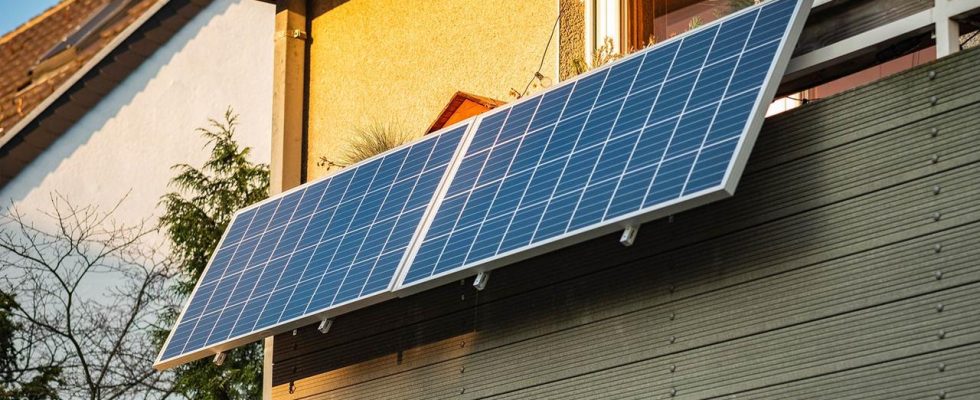faq
In Germany, more and more people are using plug-in solar systems. The federal government wants to promote this development, but progress is slow. Why? Answers to central questions.
Solar cells are hanging on more and more German balconies. In recent years, so-called balcony power plants have experienced a real boom because they are a relatively simple and affordable way for tenants to participate in the energy transition or simply save on electricity costs. Politicians are also concerned with plug-in solar systems, as the devices are correctly called. But there are still problems in some places.
How many Balcony power plants there is?
More than 400,000 of the so-called plug-in solar systems are now in operation, as can be seen from the Federal Network Agency’s market master data register as of April 2nd. In the first quarter alone, more than 50,000 systems were registered there.
In fact, both figures are likely to be even higher, since on the one hand there are unregistered investments and, on the other hand, investments can also be registered later. For comparison: nine months ago – in mid-2023 – the number of systems reported as being in operation was around 230,000.
The most systems are in North Rhine-Westphalia, with well over 80,000, followed by Bavaria with more than 60,000 and Lower Saxony with more than 50,000. At the beginning of April, almost 50,000 systems were reported for Baden-Württemberg, but the reality here is probably higher. The distribution roughly follows the country and population sizes. The city states and Saarland are at the bottom of the list.
Will the growth continue?
The German Solar Industry Association (BSW) believes it is likely that “demand for solar technology will continue to increase overall in 2024,” says Managing Director Carsten Körnig. However, market growth, which in the past was in the three-digit percentage range, will level off. It is in the nature of things that this cannot be repeated as often as desired.
In addition, there has recently been a special boom due, among other things, to the energy crisis in connection with the war of aggression against Ukraine, which is now ebbing somewhat. The change in the registration of new balcony power plants that came into force at the turn of the month could help to some extent. “Just as every disproportionate market barrier slows demand, conversely almost every reduction in bureaucracy leads to an increase in demand,” says Körnig.
“We greatly welcome the simplified registration of plug-in solar devices from April 1st as well as further efforts by the federal governments to reduce bureaucracy.” As of April 1st, the Federal Network Agency has already simplified the registration of balcony power plants in the market master data register and refers to further planned measures in a so-called solar package planned by the traffic light coalition.
What bureaucratic hurdles are there?
The federal cabinet launched the “solar package” last August. Among other things, it provides for the reduction of bureaucratic hurdles for the expansion of solar energy. Only: The package has been stuck in parliamentary deliberations for months. What is particularly controversial is the targeted support of the domestic solar industry with tax money – in view of Chinese dumping prices. The FDP doesn’t want to go along with that.
Together with the “solar package”, the traffic light factions are also negotiating a reform of the climate protection law, which is also controversial. An agreement on both projects could soon be reached. “We hope that Solar Package I will be passed in the Bundestag in April,” says the BSW.
The draft law contains a whole range of measures to reduce bureaucracy: Among other things, it is stipulated that balcony power plants no longer have to be reported to the network operator. Registration in the Federal Network Agency’s market master data register will then be sufficient.
What is the legal situation for tenants and owners?
The government wants to make it easier for homeowners and tenants to install a balcony power plant. Specifically, it concerns changes to tenancy law and condominium law. Electricity generation through plug-in solar devices should be included in the catalog of so-called privileged measures. These are structural changes that cannot simply be blocked by landlords and homeowners’ associations (WEG) – for example, conversions for accessibility, e-mobility, burglary protection and telecommunications.
Landlords and the WEG should still have a say when it comes to how a plug-in solar device is attached to the house. Whether such a system can be installed at all would then no longer be fundamentally controversial – so there should be a right to it.
To date, according to the Ministry of Justice, the installation of a plug-in solar device usually represents a structural change and requires a majority in the homeowners’ meeting. “In practice, it may be difficult to obtain the required majority,” the bill states. The following is planned for tenants: To date, the installation of a balcony power plant requires the landlord’s permission – unless this is regulated in the rental agreement. In the future, tenants should generally be able to request that their landlord allow them to make any necessary structural changes to install the device.
But: The tenant is not entitled to permission if the landlord cannot reasonably be expected to install the plug-in solar device, according to the Ministry of Justice regarding the draft law. But what exactly this means is not clear, criticized the German Tenants’ Association in a Bundestag hearing.
Source: dpa

